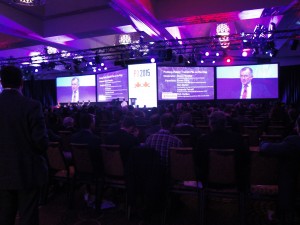
Panel discusses complexities emerging with P3s related to designers
November 4, 2015
By Bronwen Parsons
Session looks at engineering firm consolidations and what happens when the professional "stars" on the bidding team don't show up.

General session at P3 2015, Canadian Council for Public Private Partnerships conference in Toronto, November 1. Photo: CCE.
At the 23rd annual conference of the Canadian Council for Public-Private Partnerships in Toronto on November 2, one of the breakout sessions drew attention to some of the snags and difficulties that can be involved in P3 infrastructure contracts.
The P3 conference is a huge and glitzy affair “bringing together 1,200 senior government and business leaders from across Canada and around the world.” The well-heeled crowd thronged the halls and ballrooms of the Sheraton Centre downtown. The business of P3s is evidently thriving: governments are becoming increasingly dependent on private consortia to design, build and operate everything from highways and transit, to jails, courthouses, hospitals, and almost everything in between.
After an opening keynote presentation by Toronto Mayor John Tory, there were big-picture general sessions, including one with the Finance Ministers of Ontario and Quebec. Another included Amanda Farrell, president and chief executive officer of Partnerships BC, and Rob Holden, former head of the Crossrail project in London, U.K..
Next were the breakout sessions, which took a more focused approach.
In “Balancing the Scales: Fine Tuning P3 Procurement” the panel consisted entirely of lawyers. Three were partners in large law firms, along with Marni Dicker, executive vice president and general counsel with Infrastructure Ontario.
Moderator Chris Bennett of Osler, Hoskin & Harcourt began by asking how many in the audience were lawyers — and about half the people in the room put up their hands!
Bennett then asked the panel to respond to issues that frequently arise in the course of P3 projects. Several of those issues relate directly to the role of engineering consultants.
First the panel discussed design compliance versus legal compliance: does a design have to be 100 per cent in accordance with the request for proposal in order to qualify? The panelists generally agreed that proponents should have some room to innovate. However, Judy Wilson, a partner with Blake, Cassels & Graydon, said she believed design compliance should be scored. She said there is a point where the design is so different to what is specified, it tips into legal non-compliance.
Owners who provide design consultation sessions for bidders to help them prepare their proposals was another issue discussed. It was suggested that these sessions can lead to the owners — consciously or unconsciously — actually coaching a favourite team in how to achieve the highest score.
Dicker said that Infrastructure Ontario ensures a level playing field by having “fairness monitors” in the room to ensure that no one bidder is given more detail than another.
The consolidation of engineering and construction companies was another hot topic. The panelists said they are increasingly facing situations where following an acquisition the combined engineering company ends up with teams on both sides of the table. Sometimes the amalgamated consulting engineering firm has one group acting on behalf of the government owner, and another group consulting for the private consortium. In other cases, the company has staff on two competing bidding teams. Obviously these situations give rise to a conflict of interest.
Dicker said that how they untangle the problem depends on what stage the project is at when the merger-acquisition of the consultants occurs. If the merger is prior to the project’s financial close, then it is their opinion that the bidder should have to replace their consultants. If the situation occurs after procurement and during construction, then they recommend the opposite: that the project owner removes the consultants from their team and allows the successful P3 bidder to keep them.
Dicker explained that Infrastructure Ontario must avoid conflicts of interest. “We pride ourselves on being fair,” she said.
Wilson agreed, the owners “have no choice but to intervene,” in these cases, but said that there are ways that consolidating firms could manage these situations by setting up ethical walls. These would involve a firm finding ways to demonstrate that it can keep its internal systems and documentation on the two projects separate.
Another panelist, Doug Sanders of Borden Ladner Gervais, felt that the design community is sophisticated enough to police itself and deal fairly in these situations.
Another bugbear for P3 project owners is “professional bid teams.” The panel discussed how owners are becoming tired of finding out that once a project gets under way, the “stars” that were part of the P3 consortium’s bidding team are not actually working on the project. One panelist said that in these scenarios, “I’m seeing pretty annoyed owners wanting to impose bigger and bigger penalties.”
Sanders explained that what is happening is that consortia sometimes bid on two or three projects and they put forward the same high-profile team on them all. Once the firm has won the contract, the team moves on.
He suggested that owners could avoid such disappointments by scoring the bidding team based only on the three lowest ranking members. He also said that the issue of losing key individuals from a P3 team is a crucial issue not just during bidding, but also during construction. On one project he said, they had 10 different project managers in the first two years.
Also on the agenda was a discussion of “interface agreements,” which apply to the operations stages of P3 projects once they’re built. When problems arise between the contractor and the party that’s operating the facility, how much should the public owner be involved? Dicker said that at Infrastructure Ontario they expect the private partners to work things out between them, but conceded that there might be a need for more monitoring and for including interface conditions to be submitted with bids.